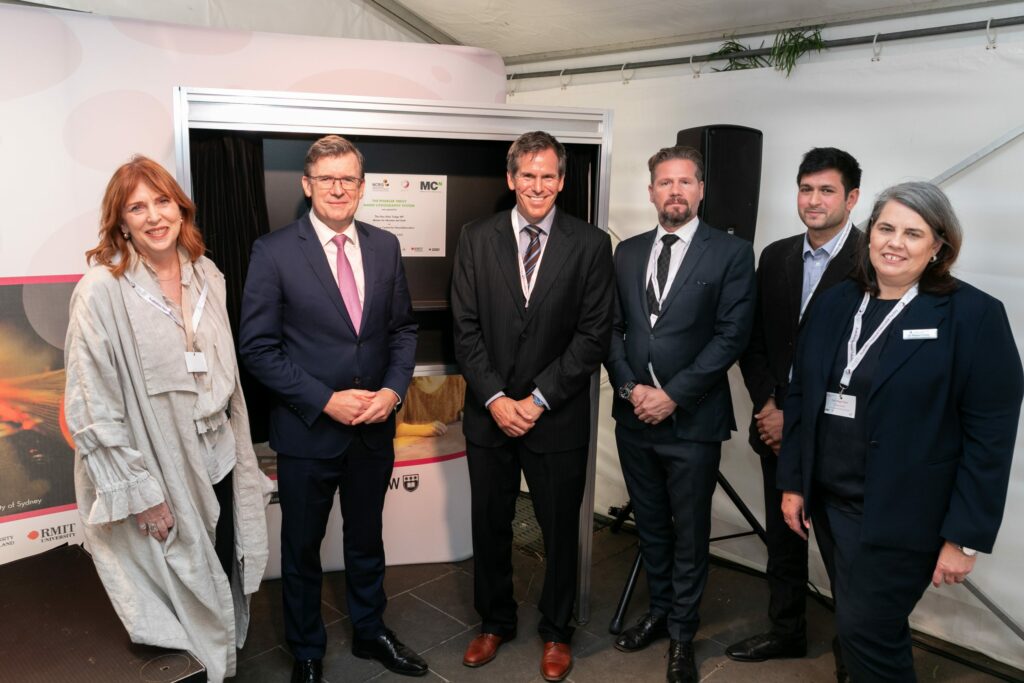Home > News & Events > The fabled Phabler unveiled by Minister for Education at MCN

Australia’s Minister for Education and Youth has officially unveiled the latest addition to the Australian National Fabrication Facility’s (ANFF) portfolio of open access R&D capabilities.
Having been officially launched, this new half-a-million-dollar tool is available, through ANFF, to industry and academia to enable production scale up of nanoscale devices, and to allow developing companies to establish a foothold in their relevant markets.
Read the Minister’s release here.
The equipment, an EULITHA Phabler 100, is a high-throughput nanopatterning system capable of processing 100’s of components a day. With a single flash of UV light it can create entire arrays of features that measure just a few hundred nanometres across, or about 1,000 times smaller than the width of a human hair. Having the ability to quickly create structures this small is essential when developing advanced medical devices, solar cells, LCD displays, nanoparticles and colour filters.
The Phabler is housed at ANFF’s flagship facility, the Melbourne Centre for Nanofabrication (MCN), which is a purpose built open-access cleanroom.
The tool has been acquired to initially support the scale up of long-term ANFF client, Professor Brian Abbey from La Trobe University, as he and his colleagues begin scaling up their smart microscope slides that can be used to more accurately diagnose cancer. By applying Professor Abbey’s nanopattern to a conventional microscope slide, it enhances the difference between healthy and cancerous cells when looking at a sample through a microscope – something that before now would have involved extensive pre-processing of samples.
Professor Abbey explained: “We will use the new Phabler facility to produce our patented slide coating which transforms conventional microscope slides into a powerful new tool for understanding disease. The resulting high-contrast images which are generated instantly, will enable faster, more accurate cancer diagnosis compared to current approaches which rely on staining or labelling.
‚ÄúUntil now, we’ve had to rely on overseas facilities for key elements in the production process. With the new facility we’re now able to manufacture our slides right here in Melbourne and in quantities that will allow us to realise the full potential of our invention.
‚ÄúWe wouldn’t have had the prototype without MCN and the ANFF.‚Äù

Credit: NanoMSlide
While the team behind these novel slides will be the primary beneficiary of this new tool, the Phabler is part of the NCRIS-funded ANFF network of micro and nanofabrication capabilities, and is therefore open for all to access.
“The platform that ANFF and NCRIS provides is a substantial accelerator to many fledgling technologies,” Dr Ian Griffiths, ANFF Chief Executive Officer said at the unveiling. “ANFF is uniquely positioned, as we can provide commercialisation support as well as continued access to a network of manufacturing capabilities and engineering talent across Australia.”
“ANFF has recently developed a pipeline of commercialisation opportunities, each born out of the use of its infrastructure. The Phabler and its use in emerging pathology technology is a clear example of how providing the right infrastructure for the right project can move an idea quickly to proof of concept products.”
The MCN is an essential part of ANFF’s Victorian Node, housing 100+ individual capabilities and a team of expert engineers that assist hundreds of clients and more than 40 companies pursue research goals.
On the unveiling, MCN and ANFF-VIC Director, Professor Nico Voelcker said: ‚ÄúToday we add yet another significant piece of open access nanofabrication infrastructure to Australia’s already extensive toolkit; a tool called Phabler that allows patterning at the nanoscale with high speed and over large areas.
“This will allow extensive academic and industry client base to scale up fabrication of devices in their translational path. And we do this in a collaborative, ISO 9001, IP neutral and customer service-focussed environment.
‚ÄúWe’re certain that many of the MCN’s 50+ industry partners will directly benefit from the ability to access this new nanopatterning capability, and that it improves the chances of success for our many clients that are working towards products of the future. I’d like to personally thank the MCN Joint Venture partners, which includes 7 of Victoria’s leading universities and the CSIRO, and both the State and Commonwealth Governments for helping to make this happen.‚Äù
The Centre itself is the result of a 10-year cooperation between seven Victorian universities and the CSIRO. It brings together the University of Melbourne; Deakin University; La Trobe University; Swinburne University of Technology; Victoria University; RMIT University; the CSIRO; and is hosted by Monash University.
Monash University President and Vice-Chancellor Professor Margaret Gardner AC said the MCN demonstrated the importance of universities and research groups such as the CSIRO, working together to solve some of the world’s greatest problems and bring extraordinary outcomes to life through start-ups and licensing agreements.
“Australia is home to world-leading researchers and infrastructure. Bringing them together into one place, where resources and expertise are shared through an industry-leading open access model, enables the translation of ground-breaking research into commercialisation to deliver real-life outcomes,” she said.
‚ÄúThe research being undertaken at MCN is proof that facilitating collaborative research through an integrated network of providers, infrastructure and expertise delivers real outcomes – which is in complete alignment with the Federal Government’s agenda to connect research with enterprise.‚Äù
